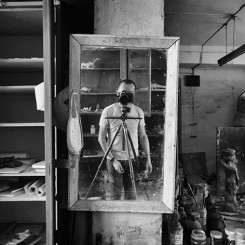Feng Mengbo solo exhibition
SGA | Shanghai Gallery of Art (3rd Floor, No.3, the Bund, Shanghai 200002, China). September 4 to October 28, 2012
For those who know Feng Mengbo’s work, the experience of being confronted with this show comes almost as a shock. Although Feng understandably shuns the epithet of “new media artist,” his work has since 1994 predominantly, or rather, obsessively used the computer and its creative potential as both tool and muse. “My Private Museum,” on the other hand, is entirely a photography show, and one that has a lot of personal devotion attached to it.
The museum that is Feng Mengbo’s object of devotion is the Shanghai Natural History Museum. Feng spent two years meticulously documenting every corner of the museum, every display case and corridor, going as far as obtaining special permission to document its dusty, abandoned backrooms. The result is a strange crossbreed between documentary, poem, and eulogy. It is a documentary because of the methodical and straightforward way each photograph has been taken. It’s apparent that he didn’t want artistic ideas to come in-between the viewer and the museum. It’s a poem because the museum itself, after years or even decades of neglect, has attained a poetic quality at the expense of its educational function. Like the romantic visions behind 19th-century European ruin paintings, decay conveys a certain poignancy; but here the decay is not a romantic fiction but reality, and the dignity of the images survives through lack of any sentimentality, and hence poignancy turns towards poetic vision that is indifferent to reality or fiction. Finally, it’s a eulogy because the images convey the loss of innocence and purity; sentimental words perhaps, but important to emphasize when they relate to the past few decades of political change.
One of the most potent aspects of this exhibition is the way Feng Mengbo has revealed or concealed the artist’s hand. The documentary-styled photos reveal a world that is familiar to those who grew up in China, but one that has become alienated through time. The dilapidation only forms a second layer of time, the first layer being the socialist era aesthetics of the original museum. These works attempt to keep the dignity of that era, when China represented a mixture of brutal political purges by the government with earnest political yearnings of the people. The care and attention given to each taxidermy specimen and each display case shines through the dust to reveal a professional honesty in stark contrast with our perception of those times. Yet the ideological nature of the displays is conveyed through a system categorizing animals in terms of their benefit or harm to human society. Innocence notwithstanding, those were the days when class war could be declared on sparrows.*
* The Great Sparrow campaign during the Great Leap Forward (1958-1962). Sparrows were identified as one of the Four Pests (rats, flies, mosquitoes, and sparrows) that were harmful to people. Sparrows were targeted because they ate grain and were killed almost to the point of extinction before leaders realized they also ate crop-eating insects. The lack of sparrows allowed locusts to thrive, decimating crops and contributing to the Great Chinese Famine.
